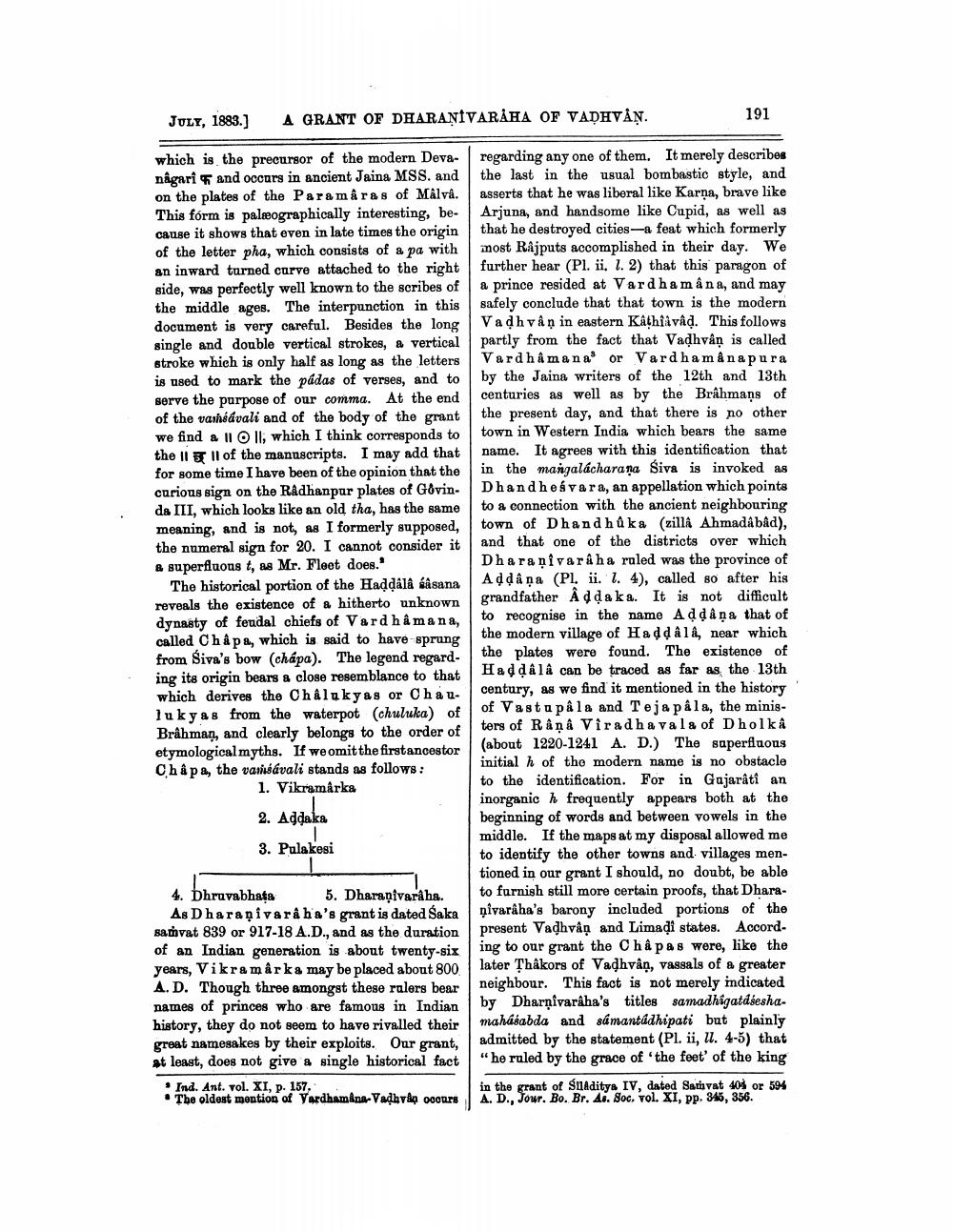________________
JULY, 1883.)
A GRANT OF DHARANIVARÁHA OF VADHVÅŅ.
191
which is the precursor of the modern Deva- nagari and occurs in ancient Jaina MSS. and on the plates of the Paramâras of Målva. This form is paleographically interesting, because it shows that even in late times the origin of the letter pha, which consists of a pa with an inward turned carve attached to the right side, was perfectly well known to the scribes of the middle ages. The interpunction in this document is very careful. Besides the long single and double vertical strokes, a vertical stroke which is only half as long as the letters is used to mark the pádas of verses, and to serve the purpose of our comma. At the end of the varnéávali and of the body of the grant we find a ll O ll, which I think corresponds to the 11 3 Il of the mannscripts. I may add that for some time I have been of the opinion that the curious sign on the Rådhanpur plates of Govin. da III, which looks like an old tha, has the same meaning, and is not, as I formerly supposed, the numeral sign for 20. I cannot consider it & superfluous t, as Mr. Fleet does."
The historical portion of the Haddala kasana reveals the existence of a hitherto unknown dynasty of feudal chiefs of Vardhamana, called Chape, which is said to have sprung from Siva's bow (chápa). The legend regarding its origin bears a close resemblance to that which derives the Chalukyas or Chau. Tu kyas from the waterpot (chuluka) of Brahman, and clearly belongs to the order of etymological myths. If we omit the firstancestor Ch â pa, the vansávali stands as follows:
1. Vikramárka 2. Addaka
regarding any one of them. It merely describes the last in the usual bombastic style, and asserts that he was liberal like Karna, brave like Arjuna, and handsome like Cupid, as well as that he destroyed cities-a feat which formerly most Rajputs accomplished in their day. We further hear (Pl. ii. 1. 2) that this paragon of a prince resided at Vardha måna, and may safely conclude that that town is the modern Vadh vâņ in eastern Kathîivad. This follows partly from the fact that Vadhván is called Vardhamanal or Vardhamanapura by the Jaina writers of the 12th and 13th centuries as well as by the Brahmans of the present day, and that there is no other town in Western India which bears the same name. It agrees with this identification that in the mangalácharaņa Śiva is invoked as Dhandheśvara, an appellation which points to a connection with the ancient neighbouring town of Dhandhaka (zilla Ahmadábåd), and that one of the districts over which Dharanivar å ha ruled was the province of Addana (Pl. i. 1. 4), called so after his grandfather Add a ka. It is not difficult to recognise in the name Addaņa that of the modern village of Hadd â 1A, near which the plates were found. The existence of Haddâlâ can be traced as far as the 13th century, as we find it mentioned in the history of Vasta pala and Teja pâla, the ministers of Rânâ Viradha vala of Dholka (about 1220-1241 A. D.) The superfluous initial h of the modern name is no obstacle to the identification. For in Gujarati an inorganic h frequently appears both at the beginning of words and between vowels in the middle. If the maps at my disposal allowed me to identify the other towns and villages mentioned in our grant I should, no doubt, be able to furnish still more certain proofs, that Dharanivaráha's barony included portions of the present Vadhvan and Limadi states. Accord ing to our grant the Châ pas were, like the later Thâkors of Vadhvåņ, vassals of a greater neighbour. This fact is not merely indicated by Dharnivardha's titles samadhigatdéeshamahasabda and samantadhipati but plainly admitted by the statement (Pl. ii, U. 4-5) that "he ruled by the grace of the feet' of the king
3. Pulakesi
4. Dhruvabhata 5. Dharanivaráha.
As Dharanivardha's grant is dated Saka samvat 839 or 917-18 A.D., and as the duration of an Indian generation is about twenty-six years, Vikramarka may be placed about 800 A. D. Though three amongst these rulers bear names of princes who are famous in Indian history, they do not seem to have rivalled their great namesakes by their exploits. Our grant, At least, does not give a single historical fact
Ind. Ant. vol. XI, p. 157, • The oldest mention of Vardhamana-Vadhvan occurs
in the grant of SilAditya IV, dated Samvat 404 or 594 A. D., Jour. Bo. Br. As. Soc. vol. XI, pp. 345, 356.




